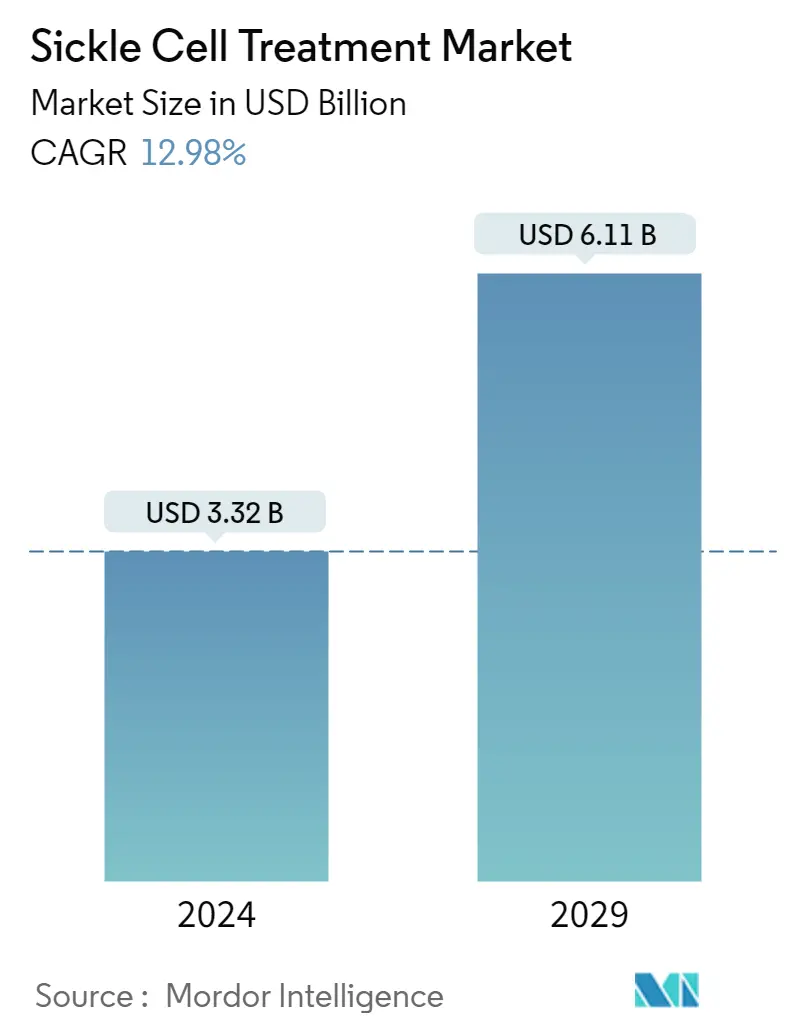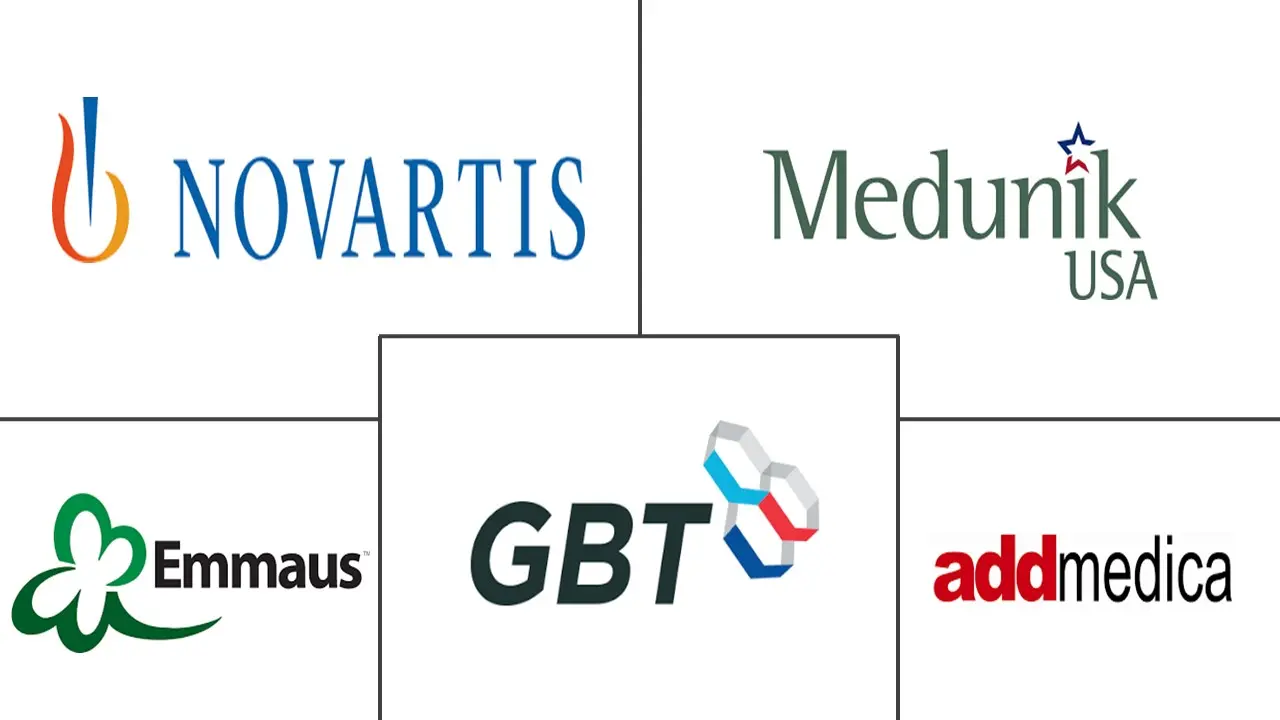Market Size of Sickle Cell Treatment Industry

| Study Period | 2019 - 2029 |
| Market Size (2024) | USD 3.32 Billion |
| Market Size (2029) | USD 6.11 Billion |
| CAGR (2024 - 2029) | 12.98 % |
| Fastest Growing Market | Asia-Pacific |
| Largest Market | North America |
Major Players
*Disclaimer: Major Players sorted in no particular order |
Sickle Cell Treatment Market Analysis
The Sickle Cell Treatment Market size is estimated at USD 3.32 billion in 2024, and is expected to reach USD 6.11 billion by 2029, growing at a CAGR of 12.98% during the forecast period (2024-2029).
The impact of the COVID-19 pandemic on the studied market was significant. For instance, according to the data updated by the American Society of Hematology in May 2021, it was stated that CDC has designated sickle cell disease (SCD) as one of the medical conditions with a very high risk for severe COVID-19. Thus, the COVID-19 pandemic significantly impacted the market's growth during the initial phase. However, as the pandemic has currently subsided, the market is expected to have normal growth during the forecast period.
Factors such as the increasing prevalence of sickle cell disease and the increasing R&D activities regarding sickle cell disease are expected to boost the market's growth.
According to an article published by HemaSphere in June 2022, sickle cell disease (SCD) is said to have a high prevalence and social impact worldwide, with high mortality within the first three years of life. A high prevalence of the disease has been reported in Sub-Saharan Africa, the Mediterranean, the Middle East, and India. It has also been estimated that the prevalence is increasing in other geographic regions with global migration. Thus, the rising prevalence of sickle cell disease is expected to boost the market's growth during the forecast period.
The rising initiatives by various governments and private organizations for the treatment of this disease are expected to drive the market in the coming years. For instance, according to the data published by the WHO in August 2022, a few African health ministers launched a campaign to ramp up awareness and bolster prevention and care to reduce the toll of sickle cell disease, which is one of the most common illnesses in the region, but which receives inadequate attention. The source also stated that more than 66% of the 120 million people affected worldwide by sickle cell disease live in Africa. Approximately 1,000 children are born with the disease every day in Africa, making it the region's most prevalent genetically acquired disease. Thus, the high prevalence of sickle cell disease and the increasing awareness campaigns for the treatment of this disease are some of the key market drivers.
The increasing R&D for sickle cell disease may also drive the market. For instance, in May 2022, multiple daily doses of GBT601, Global Blood Therapeutics' (GBT) experimental oral therapy for sickle cell disease (SCD), was well tolerated and showed promising pharmacological and efficacy signals in six patients in a phase I trial clinical trial.
Thus, factors such as the rising prevalence of sickle cell disease, the increasing awareness campaigns, and the rising R&D are expected to boost the market's growth. However, the high cost of treatment is expected to restrain this growth.
Sickle Cell Treatment Industry Segmentation
As per the scope of the report, sickle cell is a group of disorders that cause red blood cells to become misshapen and break down. With sickle cell disease, an inherited group of disorders, red blood cells contort into a sickle shape. The cells die early, leaving a shortage of healthy red blood cells (sickle cell anemia), and can block blood flow, causing pain (sickle cell crisis).
The sickle cell treatment market is segmented by treatment modality (bone marrow transplant, blood transfusion, and pharmacotherapy), end user (hospitals, specialty clinics, and other end users), geography (North America, Europe, Asia-Pacific, Middle East and Africa, and South America). The market report also covers the estimated market sizes and trends for 17 countries across major regions globally. The report offers the value (in USD million) for the above segments.
| By Treatment Modality | |
| Blood Transfusion | |
| Bone Marrow Transplant | |
| Pharmacotherapy |
| By End User | |
| Hospitals | |
| Specialty Clinics | |
| Other End Users |
| By Geography | ||||||||
| ||||||||
| ||||||||
| ||||||||
| ||||||||
|
Sickle Cell Treatment Market Size Summary
The sickle cell treatment market is poised for significant growth over the forecast period, driven by the increasing prevalence of sickle cell disease and heightened research and development activities. The market's expansion is supported by rising awareness campaigns and initiatives from both government and private organizations aimed at addressing the disease's impact, particularly in regions with high prevalence such as Sub-Saharan Africa, the Mediterranean, the Middle East, and India. The market's growth trajectory is further bolstered by advancements in treatment options, including promising clinical trials for new therapies. However, the high cost of treatment remains a challenge that could potentially restrain market growth.
North America is expected to hold a substantial share of the sickle cell treatment market, with the United States leading due to improved access to treatments and strong government support. The region's growth is fueled by the rising prevalence of sickle cell disease, an increase in clinical trials, and new product launches. Key market players are actively developing novel therapies, contributing to the competitive landscape. The market's dynamics are shaped by both regional and global companies, with ongoing innovations and regulatory approvals playing a crucial role in shaping the future of sickle cell treatment.
Sickle Cell Treatment Market Size - Table of Contents
-
1. MARKET DYNAMICS
-
1.1 Market Overview
-
1.2 Market Drivers
-
1.2.1 Increasing Prevalence of Sickle Cell Disease
-
1.2.2 Increasing R&D Activity
-
-
1.3 Market Restraints
-
1.3.1 High Cost of Treatment
-
-
1.4 Porter's Five Forces Analysis
-
1.4.1 Threat of New Entrants
-
1.4.2 Bargaining Power of Buyers/Consumers
-
1.4.3 Bargaining Power of Suppliers
-
1.4.4 Threat of Substitute Products
-
1.4.5 Intensity of Competitive Rivalry
-
-
-
2. MARKET SEGMENTATION (Market Size by Value - USD million)
-
2.1 By Treatment Modality
-
2.1.1 Blood Transfusion
-
2.1.2 Bone Marrow Transplant
-
2.1.3 Pharmacotherapy
-
-
2.2 By End User
-
2.2.1 Hospitals
-
2.2.2 Specialty Clinics
-
2.2.3 Other End Users
-
-
2.3 By Geography
-
2.3.1 North America
-
2.3.1.1 United States
-
2.3.1.2 Canada
-
2.3.1.3 Mexico
-
-
2.3.2 Europe
-
2.3.2.1 Germany
-
2.3.2.2 United Kingdom
-
2.3.2.3 France
-
2.3.2.4 Italy
-
2.3.2.5 Spain
-
2.3.2.6 Rest of Europe
-
-
2.3.3 Asia-Pacific
-
2.3.3.1 China
-
2.3.3.2 Japan
-
2.3.3.3 India
-
2.3.3.4 Australia
-
2.3.3.5 South Korea
-
2.3.3.6 Rest of Asia-Pacific
-
-
2.3.4 Middle East and Africa
-
2.3.4.1 GCC
-
2.3.4.2 South Africa
-
2.3.4.3 Rest of Middle East and Africa
-
-
2.3.5 South America
-
2.3.5.1 Brazil
-
2.3.5.2 Argentina
-
2.3.5.3 Rest of South America
-
-
-
Sickle Cell Treatment Market Size FAQs
How big is the Sickle Cell Treatment Market?
The Sickle Cell Treatment Market size is expected to reach USD 3.32 billion in 2024 and grow at a CAGR of 12.98% to reach USD 6.11 billion by 2029.
What is the current Sickle Cell Treatment Market size?
In 2024, the Sickle Cell Treatment Market size is expected to reach USD 3.32 billion.

